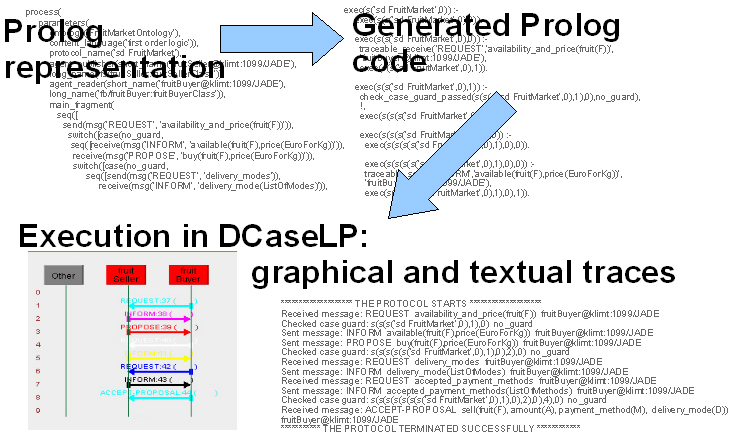AUML2WS-BPEL
Description
The AUML2WS-BPEL translator implements the translation depicted in the figure below.

The Prolog representation obtained by the above translation can be used to automatically generate the Prolog code of two agents that adhere to the agent interaction protocol defined by the AUML diagram. These agents can be executed inside the JADE platform extended with the DCaseLP libraries, as depicted in the figure below.

AUML2WS-BPEL takes an AUML visual Agent Interaction Protocol (AIP) and generates the WSDL and WS-BPEL documents that correspond to it, using an XML-based notation for AUML developed by ourselves as intermediate format.
Since currently no editors for AUML exist, we limited ourselves to consider only those features that AUML shares with UML 2.0, and only a subset of them, in order to edit the AUML AIPs with existing tools for UML.
Our translator, developed in Java, takes as input the XMI description of a UML 2.0 sequence diagram (corresponding to an AUML interaction protocol). By exploiting the Extensible Stylesheet Language Transformations (XSLT) technology, the features of the XMI document relevant for generating the AUML textual notation are extracted and a document in Winikoff’s textual notation ["Towards making Agent UML practical: A textual notation and a tool", ISEAT 2005], another one in our XML-based notation, and a third one containing a Prolog term, are generated.
The XML-based document is used by another XSLT sheet, to generate both the WSDL and the WS-BPEL documents.
We have tested the translator drawing the UML 2.0 sequence diagrams with Poseidon , and exporting them into XMI. It should be possible to use any other UML editor supporting the 2.0 version.
Download and installation instructions
- Download AUML2WS-BPEL
- Follow the instructions contained in the README file
- Download the DISI technical report DISI-TR-06-01 that describes the AUML2WS-BPEL translator and the motivations behind its development
Credits
- The main effort in the design and implementation of the AUML2WS-BPEL translator and in its testing has been made by Giovanni Casella , under the guidance of Viviana Mascardi .
Disclaimer
The AUML2WS-BPEL translator is still under testing. You may download and use it (in this case, we would be very happy to be informed), but please take into account that its debugging has not been completed yet.
For the moment, only option, seq, loop, and alt UML 2.0 operators are translated into the corresponding if-then, sequence, while and switch WS-BPEL activities.
Comments in the code are sometimes still in Italian.
Suggestions are welcome: please send them to Giovanni Casella
Please send suggestions and comments to: Viviana Mascardi viviana.mascardi@unige.it
Last Updated: April, 2013

